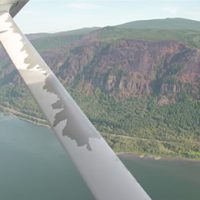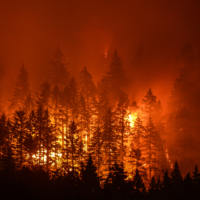All forested ecosystems are departed from their natural fire cycles, some more than others.
Dry forests have perhaps suffered the most from a fire deficit because they have missed fires at two important scales. For example, at a local scale, each patch of dry forest experienced a fire every 5-25 years, and at a landscape scale, across the set of all dry forest patches, fire was always happening somewhere, and there was variability in fire intensity. Most patches experienced low or mixed intensity fires, driven mainly by surface fire, but some patches experienced high severity fires — yielding a bit of variability in successional conditions.
In the case of the Columbia River Gorge fires, these moister forests typically experienced fire on average every 200-300 years. Fires in these moist forests burned at mixed or high intensity, creating a mosaic of successional conditions within one fire event area. And like the dry forest, some portion of the moist forest was always burning, each year, such that the entire moist forest area was rarely all forested. Instead, 20 to 40 percent of the moist forest was in a recently burned or recovering condition. This meant that the entire moist forest was not available to burn at any one time.
Fire suppression, widespread livestock grazing, and selective logging that removed large, fire-resistant trees has significantly altered these historical fire regimes. Science-based thinning and reintroduced or prescribed fire that creates a mosaic of forest conditions can help restore proper functioning fire regimes in our forests.
There will be more wildfires. Fortunately, fires are an important ecosystem process. These facts have led to the near consensus in the scientific and management community that our relationship with fire must change. As we continue to transition to the new fire management paradigm, it is imperative that these beneficial fires do not result in policies that expand short-term economic gain at the expense of long-term forest resiliency and the ecosystem services they provide.


